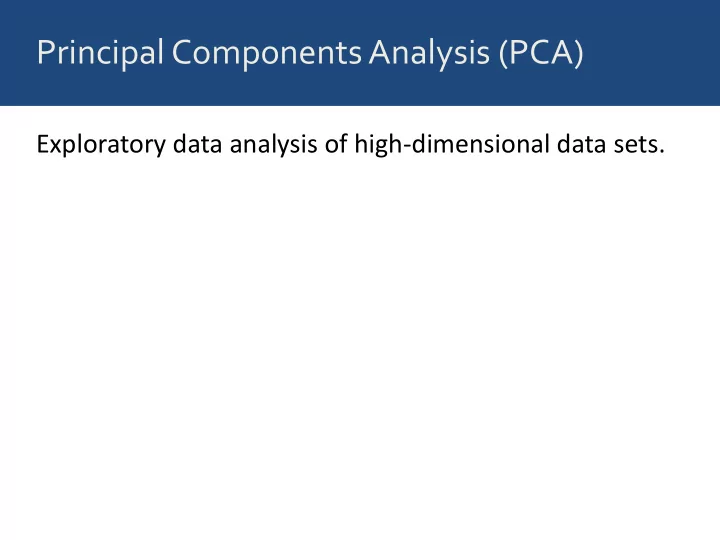

Principal Components Analysis (PCA) Exploratory data analysis of high-dimensional data sets.
Example: Consider a data set of heights and weights of people
Example: Consider a data set of heights and weights of people Overall size
Example: Consider a data set of heights and weights of people Overall size “Heaviness”
PCA on this data set reframes data in terms of overall size and heavyness less heavy heavier bigger smaller
The math behind PCA Variance of one variable: Var( X ) = 1 ∑ ( x − x j ) 2 2 = σ X n j Covariance of two variables: Cov( X , Y ) = 1 ∑ 2 ( x − x j )( y − y j ) = σ XY n j
The math behind PCA Covariance matrix of n variables X 1 . . . X n : ⎛ ⎞ 2 2 ! 2 σ 11 σ 12 σ 1 n ⎜ ⎟ ⎜ ⎟ ! 2 2 2 σ 21 σ 22 σ 2 n C = ⎜ ⎟ ! ! " ! ⎜ ⎟ ⎜ ⎟ 2 2 ! 2 σ n 1 σ n 2 σ nn ⎝ ⎠
The math behind PCA PCA diagonalizes the covariance matrix C : C = UDU T ⎛ ⎞ 2 ! 0 0 λ 1 ⎜ ⎟ ⎜ ⎟ ! 2 0 0 λ 2 U T = U ⎜ ⎟ " " # " ⎜ ⎟ ⎜ ⎟ ! 2 0 0 λ n ⎝ ⎠
The math behind PCA PCA diagonalizes the covariance matrix C : C = UDU T ⎛ ⎞ 2 ! 0 0 λ 1 rotation matrix ⎜ ⎟ ⎜ ⎟ ! 2 0 0 λ 2 U T = U ⎜ ⎟ " " # " ⎜ ⎟ ⎜ ⎟ ! 2 0 0 λ n ⎝ ⎠
The math behind PCA PCA diagonalizes the covariance matrix C : C = UDU T ⎛ ⎞ 2 ! 0 0 λ 1 diagonal matrix ⎜ ⎟ ⎜ ⎟ ! 2 0 0 λ 2 U T = U ⎜ ⎟ " " # " ⎜ ⎟ ⎜ ⎟ ! 2 0 0 λ n ⎝ ⎠
The math behind PCA PCA diagonalizes the covariance matrix C : C = UDU T ⎛ ⎞ 2 ! 0 0 λ 1 ⎜ ⎟ ⎜ ⎟ ! 2 0 0 λ 2 U T = U ⎜ ⎟ " " # " ⎜ ⎟ ⎜ ⎟ ! 2 0 0 λ n ⎝ ⎠ eigenvalues (= variance explained by each component)
The math behind PCA PCA diagonalizes the covariance matrix C : C = UDU T ⎛ ⎞ 2 ! 0 0 λ 1 ⎜ ⎟ ⎜ ⎟ ! 2 0 0 λ 2 U T = U ⎜ ⎟ " " # " ⎜ ⎟ ⎜ ⎟ ! 2 0 0 λ n ⎝ ⎠ covariance between components is zero (they are uncorrelated)
In our earlier example, overall size and heaviness are uncorrelated
Doing a PCA in R iris %>% select(-Species) %>% # remove Species column scale() %>% # scale to zero mean # and unit variance prcomp() -> # do PCA pca # store result # in variable “pca”
Doing a PCA in R > pca Standard deviations: [1] 1.7083611 0.9560494 0.3830886 0.1439265 Rotation: PC1 PC2 PC3 PC4 Sepal.Length 0.5210659 -0.37741762 0.7195664 0.2612863 Sepal.Width -0.2693474 -0.92329566 -0.2443818 -0.1235096 Petal.Length 0.5804131 -0.02449161 -0.1421264 -0.8014492 Petal.Width 0.5648565 -0.06694199 -0.6342727 0.5235971
Doing a PCA in R > pca Standard deviations: [1] 1.7083611 0.9560494 0.3830886 0.1439265 Rotation: PC1 PC2 PC3 PC4 Sepal.Length 0.5210659 -0.37741762 0.7195664 0.2612863 Sepal.Width -0.2693474 -0.92329566 -0.2443818 -0.1235096 Petal.Length 0.5804131 -0.02449161 -0.1421264 -0.8014492 Petal.Width 0.5648565 -0.06694199 -0.6342727 0.5235971
Squares of the std. devs represent the % variance explained by each PC
Doing a PCA in R > pca Standard deviations: [1] 1.7083611 0.9560494 0.3830886 0.1439265 Rotation: PC1 PC2 PC3 PC4 Sepal.Length 0.5210659 -0.37741762 0.7195664 0.2612863 Sepal.Width -0.2693474 -0.92329566 -0.2443818 -0.1235096 Petal.Length 0.5804131 -0.02449161 -0.1421264 -0.8014492 Petal.Width 0.5648565 -0.06694199 -0.6342727 0.5235971
The rotation matrix tells us which variables contribute to which PCs
We can also recover each original observation expressed in PC coordinates > pca$x
We can also recover each original observation expressed in PC coordinates > pca$x PC1 PC2 PC3 PC4 [1,] -2.25714118 -0.478423832 0.127279624 0.024087508 [2,] -2.07401302 0.671882687 0.233825517 0.102662845 [3,] -2.35633511 0.340766425 -0.044053900 0.028282305 [4,] -2.29170679 0.595399863 -0.090985297 -0.065735340 [5,] -2.38186270 -0.644675659 -0.015685647 -0.035802870 [6,] -2.06870061 -1.484205297 -0.026878250 0.006586116 [7,] -2.43586845 -0.047485118 -0.334350297 -0.036652767 [8,] -2.22539189 -0.222403002 0.088399352 -0.024529919 [9,] -2.32684533 1.111603700 -0.144592465 -0.026769540 [10,] -2.17703491 0.467447569 0.252918268 -0.039766068 [11,] -2.15907699 -1.040205867 0.267784001 0.016675503 [12,] -2.31836413 -0.132633999 -0.093446191 -0.133037725 [13,] -2.21104370 0.726243183 0.230140246 0.002416941
Plot of iris plants in PC coordinates reveals differences among species
These differences are much harder to see in the original variables
Recommend
More recommend